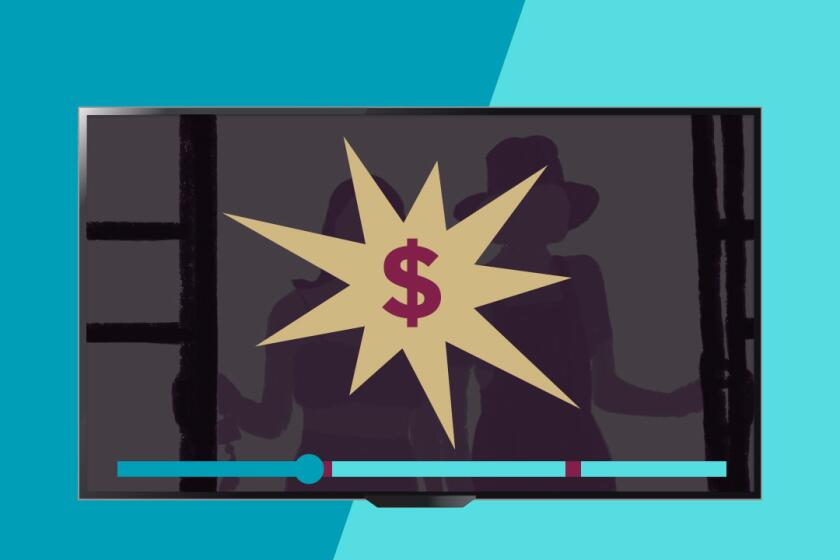How much Netflix’s new ad-supported plan will cost and what you get (and don’t)

- Share via
Commercials are coming soon to Netflix.
The Los Gatos streamer on Thursday said it would launch a cheaper, ad-supported plan at $6.99 a month starting on Nov. 3 in the U.S. Netflix will still offer ad-free subscriptions, but for people seeking a discount, an average of four to five minutes of ads will be spread out before and during their favorite programs each hour.
The company said a limited number of shows and movies won’t be available on its Basic with Ads plan because of licensing restrictions, and customers won’t have the ability to download programs.
The push into advertising comes years after Netflix resisted putting commercials on its programs. But as the company faced increasing competition from rivals like HBO Max that offered lower-cost, ad-supported subscriptions to customers, some analysts said it was inevitable that Netflix would do the same.
The company — which remains the dominant subscription streaming service with nearly 221 million customers worldwide — is under pressure by investors to continue to grow its business. The pandemic saw unprecedented sign-ups for streaming, but since then, Netflix has struggled.
Netflix lost subscribers in two consecutive quarters and laid off hundreds of workers earlier this year to cut costs.
As Netflix’s stock declines and investors ramp up pressure to continue to expand its customer base, ads on Netflix will soon become a reality.
Some analysts believe that Netflix’s move into advertising could increase subscribers, reduce cancellations and provide an additional revenue stream for the company. Advertisers will be able to target viewers based on content genres such as drama or sci-fi and will have the option of not placing their ads next to certain content, such as sex, nudity or graphic violence, Netflix said. The company said it would not be taking political ads.
Doug Anmuth, head of U.S. Internet Research at J.P. Morgan, estimates that the new plans could bring Netflix around $600 million in advertising revenue next year in the U.S. and Canada and roughly $2.65 billion in 2026 in that region.
Anmuth said in a research note that given Netflix’s muted subscription growth, “advertising is critical to re-accelerating revenue” and driving more profitability.
By offering ads, Netflix may be able to reach people who aren’t subscribers. Nine out of 10 adults who don’t have Netflix watch other ad-supported streaming content, according to a recent survey of 2,500 U.S. adults by Samba TV and Harris X.
“These audiences have no aversion to watching ads in exchange for free or reduced price content and are prime candidates to turn to Netflix’s new ad-supported tier,” Samba TV Chief Executive and Co-Founder Ashwin Navin told The Times last month.
Netflix monthly ad-free plans range from $9.99 to $19.99, two of which are seen as the most expensive compared to any popular U.S. streaming service. For example, ad-free HBO Max and Hulu is priced at $14.99 a month.
Netflix will debut its ad-supported plan before Disney+, which will launch an $8 monthly ad-supported plan on Dec. 8. At that time, the cost of an ad-free Disney+ plan will go up to $11 a month.
Free, ad-supported streaming TV services are growing fast and expected to command significantly more advertising dollars this year.
For customers who opt for ads on Netflix, 15- to 30- second ads will appear before and during their programs.
They will also be asked to provide their birthdate and gender, which Netflix says will help show more relevant ads over time.
Netflix’s ad-supported plans will launch next month in 12 countries, including the U.S., Australia, Brazil, Canada, France, Germany, Italy, Japan, South Korea, Mexico, Spain, the United Kingdom.
“We definitely believe that a lower consumer facing price, with good incremental ad monetization, will enable us to both grow membership and over time build a really significant incremental revenue and profit stream,” Greg Peters, Netflix’s chief operating officer, said at a news conference on Thursday.
As Netflix grapples with a loss in subscribers, the company’s vaunted “team” culture is coming under strain as some employees worry about their future.
Some analysts are skeptical over whether an ad-supported plan will significantly boost customer growth, or if it will cause ad-free customers to downgrade to less expensive plans.
Jeffrey Wlodarczak, a principal and analyst at Pivotal Research Group, views Netflix’s move into advertising as “defensive not offensive.”
“We also believe a lower-cost ad supported version of NFLX [Netflix] arguably taints the NFLX brand and the tech behind successful advertising delivery is very difficult ... not to mention NFLX original programming is not optimized for ad breaks,” wrote Wlodarczak in a research note. He has sell recommendation on the stock.
Peters said during the news event that the ad-supported plans offer consumers more choice, and the company’s internal teams have worked to “find those natural break points so that we can deliver the ads in the least obtrusive point.”
“We really want to take a pro consumer approach and let them land on the right plan for them and we think that the revenue model will be fine,” Peters added.
Netflix has partnered with Microsoft on its advertising efforts. On Thursday, Peters said Netflix also teamed with DoubleVerify and Integral Ad Science “to verify the viewability and traffic validity of our ads” beginning next year. Nielsen will also use its digital ad ratings in the U.S. and information will be available next year.
In addition to growing competition from rival streaming services, Netflix also faces a challenging global economy.
Kenneth Leon, research director at CFRA Research, warns that there could be more headwinds ahead as consumers could cut back on spending during a recession.
“Even though video streaming is viewed to be a value, leisure thing to do, households have way too many different types of streaming from formidable competitors of Netflix besides them,” Leon said. “So we see the risk is really recession.”
Netflix will release its third-quarter earnings on Tuesday. The company has said it estimates it will add 1 million subscribers in the third quarter, compared with a gain of 4.4 million subscribers during the third quarter last year.
Password piracy and account sharing is expected to cost streamers and pay TV providers $12.5 billion in 2024, according to Parks Associates.
More to Read
Inside the business of entertainment
The Wide Shot brings you news, analysis and insights on everything from streaming wars to production — and what it all means for the future.
You may occasionally receive promotional content from the Los Angeles Times.















